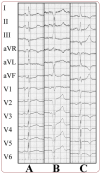Cardiac Memory - from Theory to Clinical Practice
- PMID: 31523294
- PMCID: PMC6709401
- DOI: 10.26574/maedica.2019.14.2.135
Cardiac Memory - from Theory to Clinical Practice
Abstract
Cardiac memory (CM) is defined as changes in T wave polarity and vector that appear after cessation of a period of abnormal ventricular depolarization of various causes. The mechanisms responsible for CM development are initiation by local stretch, requiring myocardial contraction, followed by a cascade of intracellular signals that lead to a reduction in repolarization currents, especially Ito. In practice, CM is a frequently encountered ECG phenomenon, especially in patients with intermittent ventricular pacing, and knowledge of the ECG pattern of CM may help quick differential diagnosis from ischemia. While CM is most often a benign finding, in rare cases, association between CM and severe bradycardia or other factors for QT prolongation may be pro-arrhythmic and requires emergency care.
Figures



References
-
- Rosenbaum MB, Blanco HH, Elizari MV, et al. Electrotonic modulation of the T wave and cardiac memory. Am J Cardiol. 1982;50:213–222. - PubMed
-
- Jeyaraj D, Wilson LD, Zhong J, et al. Mechanoelectrical feedback as novel mechanism of cardiac electrical remodeling. Circulation. 2007;115:3145–3155. - PubMed
-
- Sosunov EA, Anyukhovsky EP, Rosen MR. Altered ventricular stretch contributes to initiation of cardiac memory. Heart Rhythm. 2008;5:106–113. - PubMed
-
- Yu H, McKinnon D, Dixon JE, et al. Transient outward current, Ito1, is altered in cardiac memory. Circulation. 1999;99:1898–1905. - PubMed
-
- Geller JC, Rosen MR. Persistent T-wave changes after alteration of the ventricular activation sequence. New insights into cellular mechanisms of cardiac memory. Circulation. 1993;88:1811–1819. - PubMed
Publication types
LinkOut - more resources
Full Text Sources
